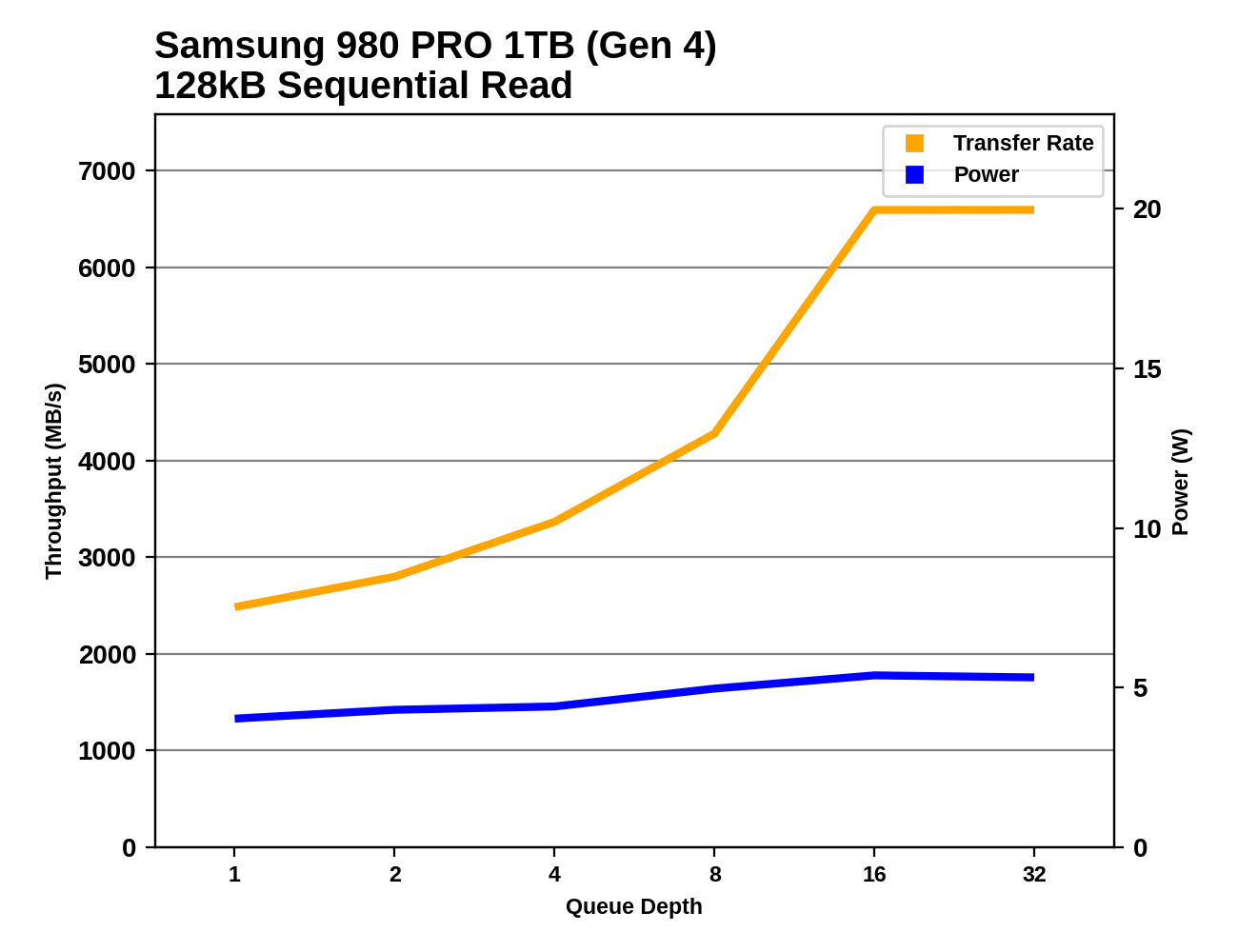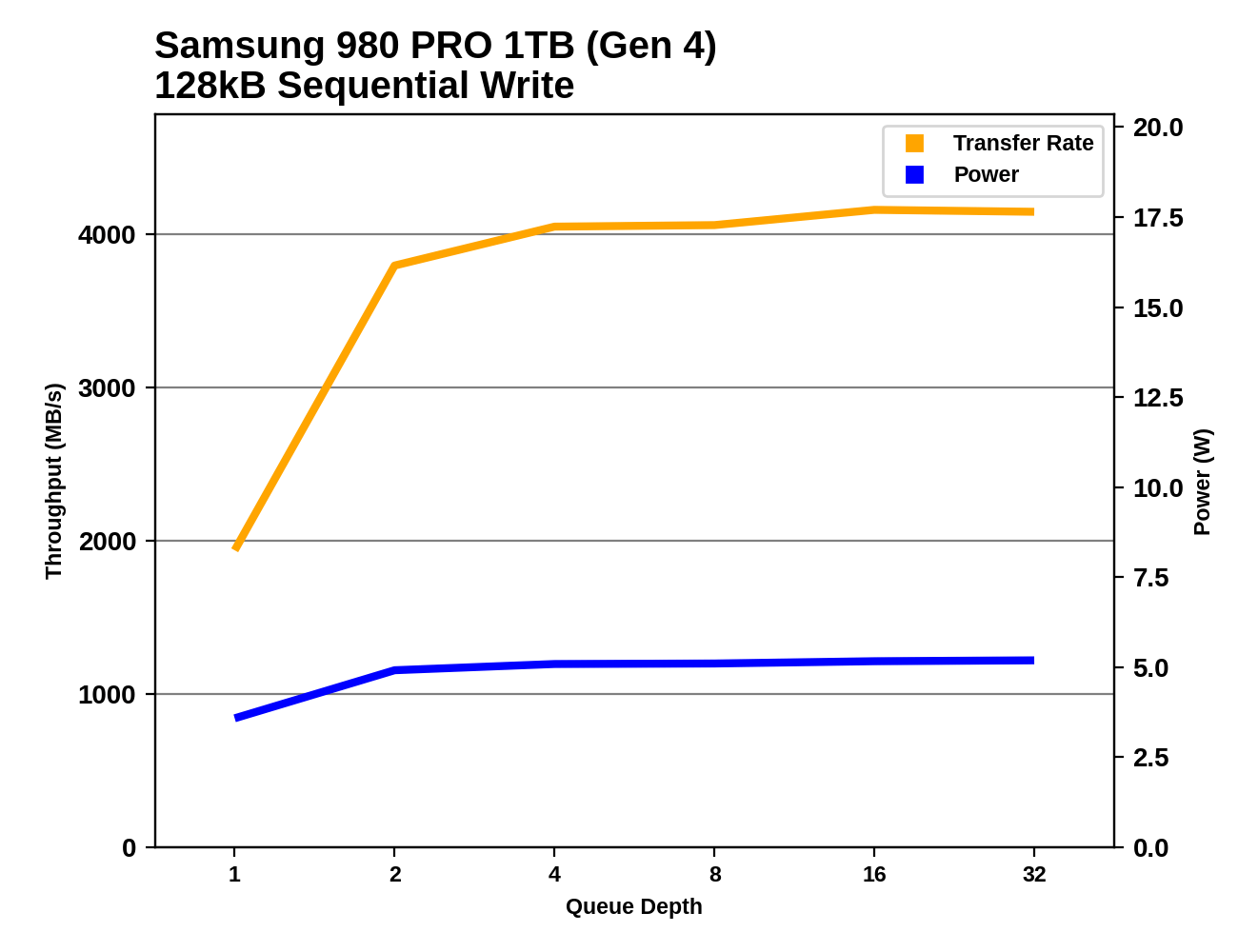The Samsung 980 PRO PCIe 4.0 SSD Review: A Spirit of Hope
by Billy Tallis on September 22, 2020 11:20 AM ESTNote: All our previous testing has been on an Intel test bed. Because of the move to PCIe 4.0, we have upgraded to Ryzen. Devices tested under Ryzen in time for this review are identified in the charts.
Sequential Read Performance
Our first test of sequential read performance uses short bursts of 128MB, issued as 128kB operations with no queuing. The test averages performance across eight bursts for a total of 1GB of data transferred from a drive containing 16GB of data. Between each burst the drive is given enough idle time to keep the overall duty cycle at 20%.

The burst sequential read performance of the Samsung 980 PRO is marginally faster than its predecessors, but the extra PCIe Gen4 bandwidth doesn't matter with a queue depth of just one. The drives using the SM2262EN controller stay on the top of this chart.
Our test of sustained sequential reads uses queue depths from 1 to 32, with the performance and power scores computed as the average of QD1, QD2 and QD4. Each queue depth is tested for up to one minute or 32GB transferred, from a drive containing 64GB of data. This test is run twice: once with the drive prepared by sequentially writing the test data, and again after the random write test has mixed things up, causing fragmentation inside the SSD that isn't visible to the OS. These two scores represent the two extremes of how the drive would perform under real-world usage, where wear leveling and modifications to some existing data will create some internal fragmentation that degrades performance, but usually not to the extent shown here.

On the longer sequential read test, the 980 PRO no longer has a clear advantage over its predecessors. The 250GB 980 PRO is slightly slower than the 970 EVO Plus even on our new testbed. The 1TB 980 PRO shows slight improvement in its performance reading back data that wasn't written sequentially, but the 970 PRO and the SK hynix Gold P31 are still significantly faster for that task.
 |
|||||||||
| Power Efficiency in MB/s/W | Average Power in W | ||||||||
The power efficiency scores for the 980 PRO on the sequential read test are a mixed bag. Overall, the scores are still good for a high-end NVMe drive, but it doesn't consistently improve over its predecessors, and when it does score better the improvement is small.
 |
|||||||||
The 980 PRO's sequential read performance doesn't saturate until around QD16: rather late in the test compared to most drives, but that's because high-end PCIe Gen3 drives have been hitting the host bandwidth limit at moderate queue depths. The 1TB 980 PRO does show decent performance scaling through the lower queue depths, taking it past the PCIe Gen3 limits by QD8. This is a clear improvement over the Phison E16-based Seagate FireCuda 520, which doesn't start gaining speed until after QD4.
The 250GB 980 PRO falters midway through the sequential read test, with performance dropping at QD4 and QD8, on both of our testbeds. At QD16 and higher it's still well above the PCIe Gen3 speed limit, but at lower queue depths it isn't an improvement over the 970 EVO Plus.
The sequential read performance of the 980 PRO—with sufficiently high queue depths—goes far beyond what's possible with PCIe Gen3, and the 1TB model stands out dramatically as significantly faster than even the Phison E16 drive. The E16 looks like an extrapolation of the high side of the general power/performance curve, but the 980 PRO blows past 6GB/s with power draw that would still be reasonable at half the speed.
Sequential Write Performance
Our test of sequential write burst performance is structured identically to the sequential read burst performance test save for the direction of the data transfer. Each burst writes 128MB as 128kB operations issued at QD1, for a total of 1GB of data written to a drive containing 16GB of data.

The burst sequential write speed scores for high-end NVMe drives have been fairly boring, with a narrow spread of scores for a wide variety of drives. The PCIe Gen4 drives break out of that rut and deliver real improvement to this QD1 performance, but the Phison E16-based Seagate FireCuda 520 is well ahead of the Samsung 980 PRO on this test.
Our test of sustained sequential writes is structured identically to our sustained sequential read test, save for the direction of the data transfers. Queue depths range from 1 to 32 and each queue depth is tested for up to one minute or 32GB, followed by up to one minute of idle time for the drive to cool off and perform garbage collection. The test is confined to a 64GB span of the drive.

On the longer sequential write test that includes low to moderate queue depths, the 980 PRO and the Phison E16 drive end up roughly tied, with the 980 PRO only 1% ahead overall. The smaller 250GB 980 PRO is a bit on the slow side compared to most of the 1TB drives, but it's several times faster than the 250GB 970 EVO Plus thanks to the larger SLC cache.
 |
|||||||||
| Power Efficiency in MB/s/W | Average Power in W | ||||||||
Since the 980 PROs are able to make good use of their high performance on this test, it's not too surprising that they post good efficiency scores for sequential writes. But even when tested on a PCIe Gen3 system the 980 PROs remain significantly more efficient than the 8-channel Gen3 drives, so the 980 PROs are also doing a good job of scaling down power consumption at lower speeds.
 |
|||||||||
At QD2 the 1TB 980 PRO's sequential write speed is already well above the practical limit for PCIe Gen3, but further increases in queue depth don't bring much more performance. The 980 PRO is generally a bit faster and more consistent than the Seagate FireCuda 520 on this test. The 250GB 980 PRO doesn't see any benefit from PCIe Gen4 execpt at QD1, because its SLC cache write speed doesn't come close to the PCIe Gen3 limit. Unlike the random write test, the 250GB 980 PRO makes it all the way through the sequential write test without running out of cache or experiencing a performance drop.
The two 1TB PCIe Gen4 drives extend the same power/performance trend set by most of the high-end Gen3 NVMe SSDs. The 980 PRO falls toward the more efficient side of that trend while the Phison E16-based Seagate drive is more power hungry and approaches the reasonable limits for M.2 drives.












137 Comments
View All Comments
Luckz - Thursday, September 24, 2020 - link
At reasonable things like 4K random IOPS, the 1TB P31 seems to crush the 2TB Evo Plus.Notmyusualid - Tuesday, October 6, 2020 - link
@ Hifi.. - yes totally agree on the latency.That is why TODAY I just received my 1TB 970 Pro for my laptop. Even choosing it over the 980's... it was the Avg write latency table that sealed the deal for me. (See ATSB Heavy / Write)
My Toshiba X5GP 2TB (supposedly enterprise class ssd) is not able to keep up with the huge writes my system endures most days. My write performance drops by about 10x, and when I replay my data, there are clear drop-outs.
The loss of capacity will be a pain, but I'll push old data to the 2TB, as reads on that disk are normal, and if I need to work on a data set, I'll just have to pull it across to the 970 Pro again.
My 2c.
romrunning - Tuesday, September 22, 2020 - link
What this review has done for me is to whet my appetite for an Optane drive. I'm looking forward to seeing how the new AlderStream Optane drives perform!viktorp - Wednesday, September 23, 2020 - link
Right here with you. Goodbye Samsung, nice knowing you.Will advise all my clients to stay away form Samsung for mission critical storage.
Wish we had a choice of selecting SLC, MLC, TLC, trading capacity for reliability, if desired.
_Rain - Wednesday, September 23, 2020 - link
For the sake of your clients, please advice them to use enterprise drives for mission critical storage.Those Qvos, Evos and Pros are just client storage drives and not meant for anything critical.
and of course you can limit the drives capacity to lesser value in order to gain some spare endurance. For example quote 384GB on 512GB drive will definitely double your endurance.
FunBunny2 - Wednesday, September 23, 2020 - link
"please advice them to use enterprise drives for mission critical storage."does anyone, besides me of course, remember when STEC made 'the best enterprise' SSD? anybody even know about STEC? or any of the other niche 'enterprise' SSD vendors?
XabanakFanatik - Tuesday, September 22, 2020 - link
It's almost like my comment on the previous article about the anandtech bench showing the 970 Pro is still faster due to the move to TLC were accurate.On the random, when the 980 beats the 970 pro it's by the smallest margin.
Samsung has really let the professionals like myself that bought pro series drives exclusively down.
Not to mention over 2 years later than the 970 Pro and it's marginally faster sometimes outside raw burst sequential read/write.
Jorgp2 - Tuesday, September 22, 2020 - link
Don't all GPUs already decompress textures?And the consoles only have hardware compression to get the most out of their CPUs, same for their audio hardware, video decoders, and hardware scalers.
There's plenty of efficient software compression techniques, Windows 10 even added new ones that can be applied at the filesystem level. They have good compression, and very little overhead to decompress in real time.
Only downside is that it's a windows 10 feature, that means it's half baked. Setting the compression flag is ignored by windows, you have to compress manually every time.
Ryan Smith - Tuesday, September 22, 2020 - link
"Don't all GPUs already decompress textures?"Traditional lossy texture compression is closer to throwing data out at a fixed ratio than it is compression in the lossless sense. Compressed textures don't get compressed so much as texture units interpolate the missing data on the fly.
This is opposed to lossless compression, which is closer to ZIP file compression. No data is lost, but it has to be explicitly unpacked/decompressed before it can be used. Certain lossless algorithms work on compressed textures, so games store texture data with lossless compression to further keep the game install sizes down. The trade-off being that all of this data then needs uncompressed before the GPU can work on it, and that is a job traditionally done by the CPU.
jordanclock - Thursday, September 24, 2020 - link
This fast of a drive combined with DirectStorage has me very excited for this particular reason. Though, as I understand it, DirectStorage requires the game to explicitly call the API and thus needs to be built into the game, as opposed to a passive boost to every game.